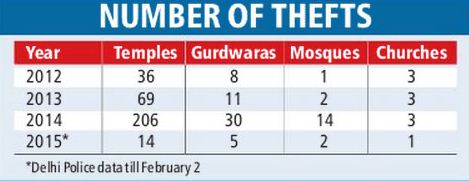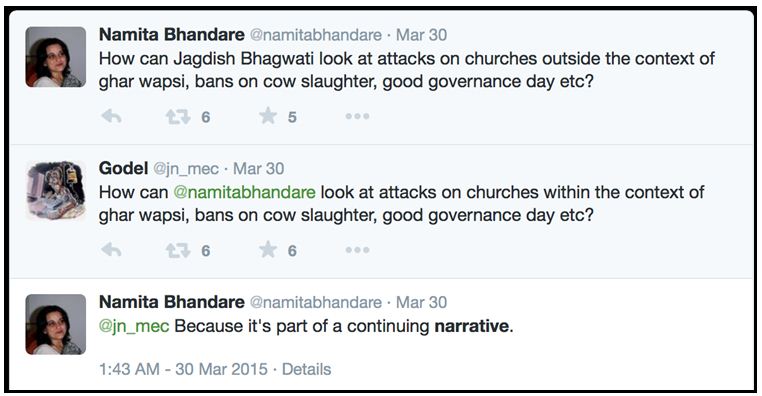Christian persecution: fact or fiction?
By selectively focusing on violent incidents in Churches, the media has created a Christians-under-siege narrative.
Where are the facts, asks SANKRANT SANU. Pix: Rana Ayyub~s piece in DailyO.
There has been a constant stream of media reports on churches being attacked, taken to fever pitch with the alleged rape of a nun in West Bengal. These incidents have been woven into a narrative of Christians being increasingly persecuted in India with the coming of the Modi government.
This has shown up in opinion pieces and in media coverage. The Times of India dedicated a full-page to the topic of “Enough, say wary Christians”; the Indian Express published a letter from no less a personage than former police chief Julio Ribeiro saying that he was feeling that he was on a “hit list”; and NDTV and Times Now have devoted multiple hours of prime time coverage to it.
There was also huge media coverage about a few thefts in Delhi churches. The question is: is this coverage proportional to the actual events or is it being made into something that it is not?
With regard to Delhi church thefts, the answer is quite clear. According to data released by the Delhi police, in 2014 206 Hindu temples, 30 Sikh Gurdwaras, 14 mosques and 3 Churches were robbed in Delhi. Yes, reading the news, which was plastered by the Delhi Church robberies, you wouldn't even know these other incidents happened.
Source: Delhi Police data quotes in the Indian Express
But by now, by repetition, the narrative of persecution has been established as the dominant one, true in its obviousness. Thus the burden of proof has been shifted to those who challenge this narrative.
Let us do a thought exercise. Let us say the media had been influenced to promote a narrative of Hindus being persecuted in India over the last 12 months. Could they do it and if so how?
In Delhi alone, according to the Delhi police, there were 206 robberies in Hindu temples. (There appears to be a real story there since, unlike Church robberies, this does seem to be disproportionately higher). If each of these temple robberies were made into front page news you could have an incident in the news practically every day.
You can add the murder of a Hindu man in Bihar for marrying a Muslim girl, the rape of a Hindu renunciate in West Bengal. Weave this one with a narrative of Christian missionaries asking converts to desecrate Hindu idols and you create the perfect storm for a communal conflagration.
The same thing could be done for any other group. Fourteen mosques were robbed in Delhi alone. Thirty gurudwaras were affected. There are nearly 25,000 rapes in India every year, nearly 500 a week. There is almost the same number of robberies. There are 35,000 murders. Selective reporting could highlight just incidents pertaining to a particular community and create a fever pitch of persecution about any community.
This comes from a failure to ask basic questions: (1) Are these incidents disproportional to the overall norm? (2) Does the data support that these incidents have increased year-over-year beyond normal statistical variance? (3) Before giving an incident, such as a Church robbery, a communal colour, is there specific evidence that this was a hate crime?
There are 6,000 hates crimes in the US every year. Hindus have experienced multiple attacks including temple vandalism with specific hate graffiti. What is missing is the hysterical coverage of Hindus being under attack and the claim that these attacks are a blot against Obama.
What is different in India is the super-imposed narrative. This hunt for a narrative is fairly clear in the coverage and in the sample tweets from journalist Namita Bhandare.
The idea is to “fit” events into this pre-determined narrative, without waiting for any evidence. The case of the alleged rape of a nun in West Bengal was the most blatant of these. Rana Ayyub spun together an opinion piece in DailyO that is an exemplar of a pre-determined narrative trumping the facts. She links RSS Chief Mohan Bhagwat’s comment that Mother Teresa’s service was done “with an intention that those served (be) converted to Christianity.” This is a fairly tame comment given the context of Teresa’s critics such as the late Christopher Hitchens. But not for Ayyub:
“An act like this required an inherent hatred of a faith and its believers. This was an act of communalism, an act of terrorism. An act which was emboldened by the support of the likes of the RSS chief who remote controls the Indian government.
No, Mohan Bhagwat these terrorists have not infiltrated from neighbouring Bangladesh... ”
Ironically, after this column was written, four Bangladeshi men were arrested by the West Bengal police for the rape. But, it is unlikely that those intent on giving criminal incidents a communal angle will be chastened by this case.
Even if Bangladeshi Muslims were involved in the rape, we should be cautious about giving it a communal angle. From the preliminary reports it looks like a property related dispute. The Church is a big landowner in the area. There is also the possibility of this being a revenge attack and that the Bangladeshis were hired for the crime. Important questions remain for journalists to raise:
1. Why did the nun disappear immediately after the rape and fly out to an “unknown destination”?
2. 2. The Vatican gave huge publicity to this case. The Church is one of the biggest landowners in India. To what extent is this foreign control of Indian land, as the Christian Action Council in Kerala has argued and is that a discussion the Church would rather keep out of the media?
3. 3. Has it been medically established that a rape took place? The CID has said charge of rape will have to be substantiated with medical proof.
The role for the media in the nun rape case has also been sensationally communal. Irrespective of the facts, it took upon itself to advance the narrative of “minorities under threat since Modi came to power.” The Indian Express ran a headline that The Archbishop clears Mamata, blames Modi. As an OpIndia analysis showed, even this headline was a sensational distortion by the Indian Express about what the Archbishop said.
Shoba Warrier, a seasoned journalists, interviews Cardinal Cleemis, President of the Catholic Bishops Conference of India, regarding the nun-rape, but fails to ask a single difficult question from the Church representative, including the issue of land deals as a motive in the nun attack case. Rather she takes the “party line”, that is the line of the Church itself and makes this into an “attack on minorities” holding Modi to account, rather than what it likely is—possibly a revenge attack related to a local issue like a property dispute.
The investigation is still ongoing. It may be a while before we know exactly what happened. Nonetheless this “nun rape” became an international story and another piece of “evidence” for how minorities, specifically Christians were being persecuted by Hindus in India, never mind the facts. The story becomes the dominant narrative, the correction does not even make it to fine print.
The narrative of Christians being persecuted in India communalizes routine incidents and created an unnecessary climate of fear. It does not help the common people, Christians or others. If anything, the Modi government has been overly solicitous of these fears. A union minster does not need to show up for a Rs. 8000 robbery in a school, a local police sub-inspector will do. The prime minister does not need to give a statement on a rape in West Bengal.
Though I wrote in Rediff taking objection to Rebeiro for his remark of being on a “hit list”, I do not blame Rebeiro. I blame irresponsible media coverage for creating a heightened sense of threat, when no evidence for this exists. I interviewed Robert Rosario, a Christian activist from Mangalore, who has been questioning the role of the Church in these incidents. He has asserted that we would be hard pressed to find even a single incident of a communal attack on a Church. Most of the Church incidents are local incidents some involving disgruntled employees, drunken rowdy behavior or other people with minor annoyances. He claimed that the Church perpetuates the idea of a community under siege to consolidate its own power and pre-empt attempts by the laity to question Church finances and governance. We need to see if these claims are valid. Unlike in other countries where the role of the Church itself is often questioned, it is surprising how Church accounts are taken at face value by the media in India.
In Pakistan recently two churches were bombed and many Christians died. That was a communal attack. To magnify minor incidents on churches into a narrative of Christian persecution in India is like “crying Wolf.” It does not help Indian Christians. It makes Christians fearful and disproportionate coverage conversely fuels resentment against the generally well-respected Christian community in India. The media’s role in fueling the communal fires of discord (to what aim?) must be examined.
Sankrant Sanu (@sankrant) is an author, entrepreneur and researcher based in Seattle and Gurgaon.
Such articles are only possible because of your support. Help the Hoot. The Hoot is an independent initiative of the Media Foundation and requires funds for independent media monitoring. Please support us. Every rupee helps.









